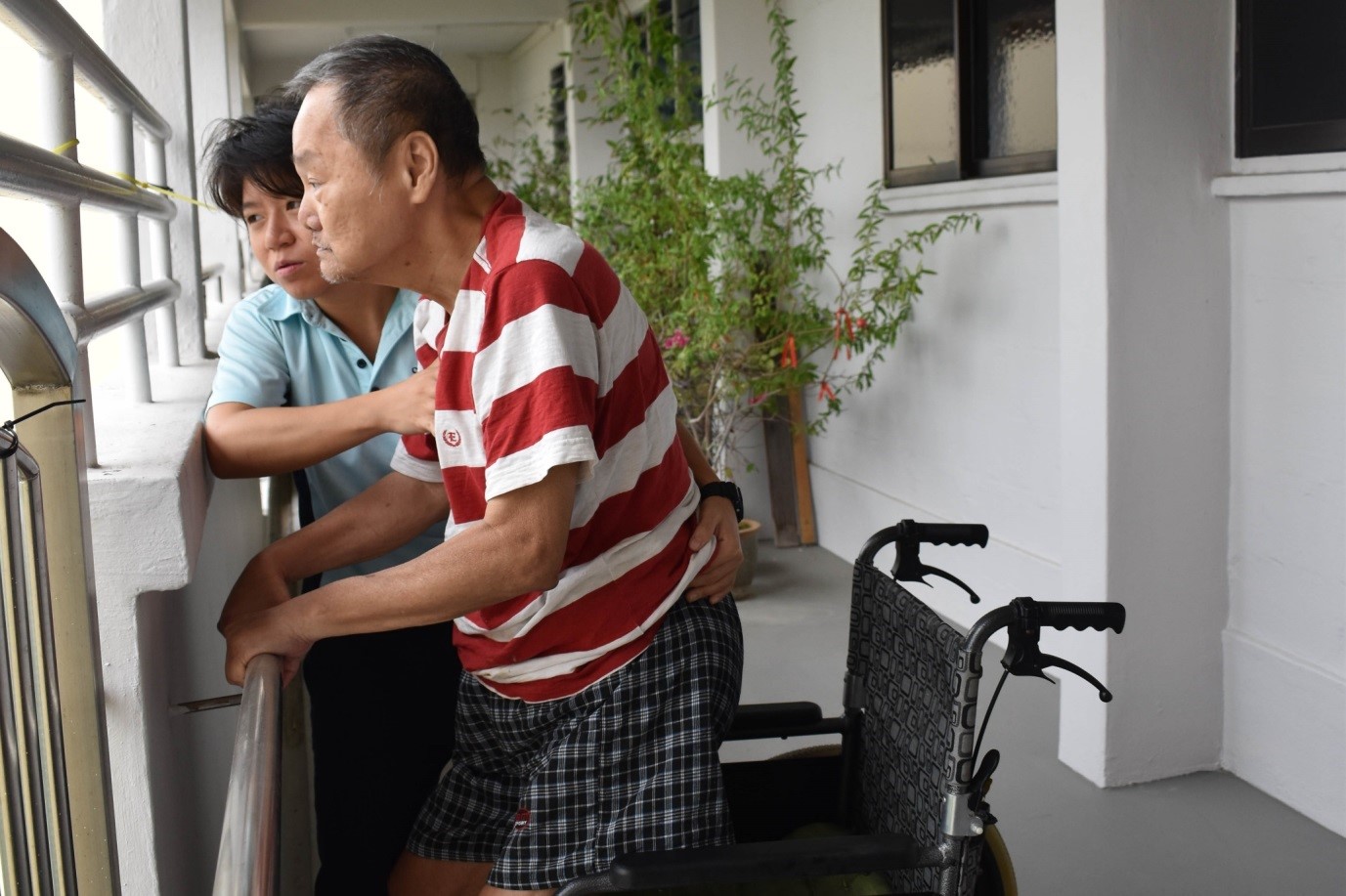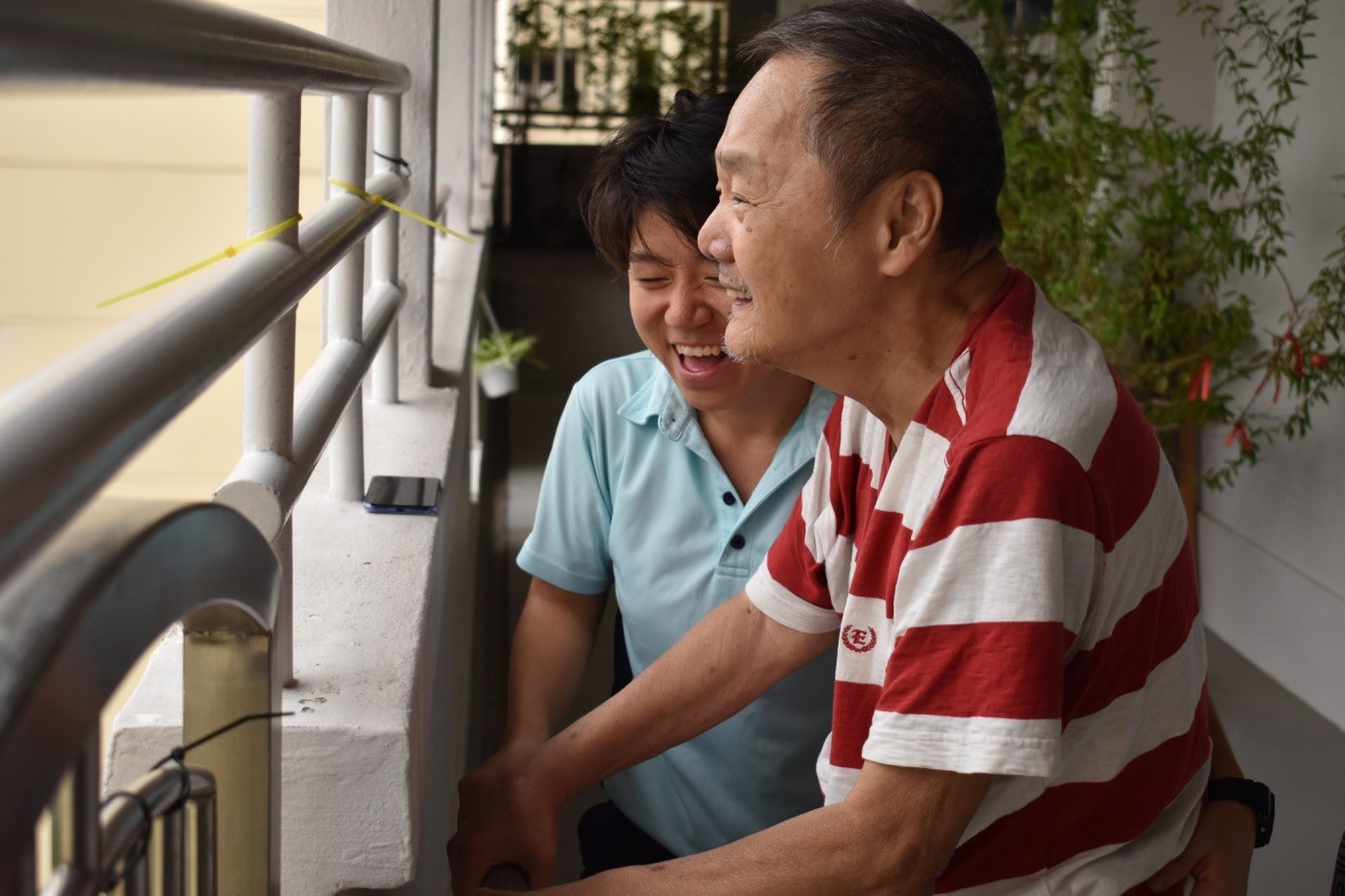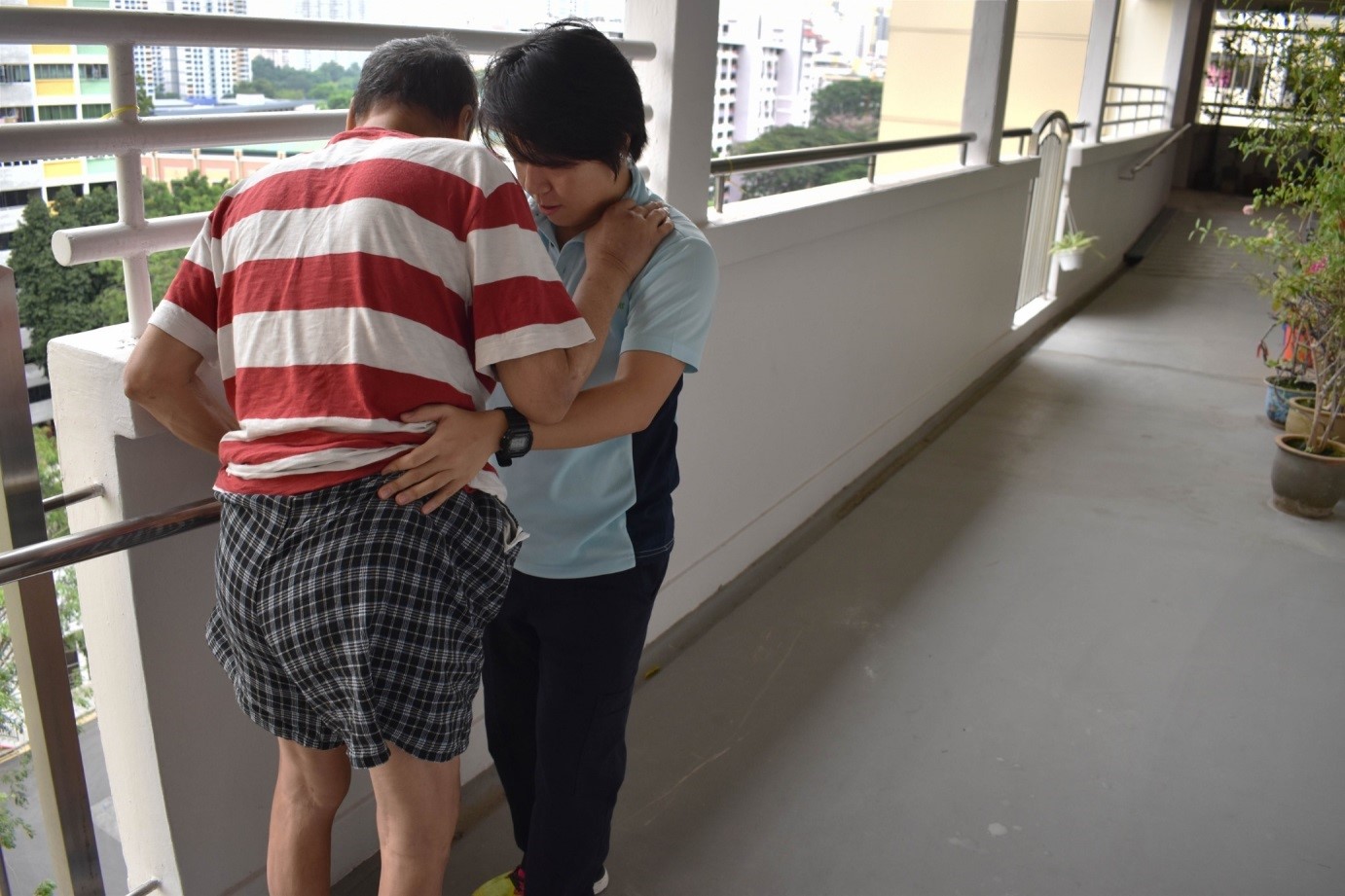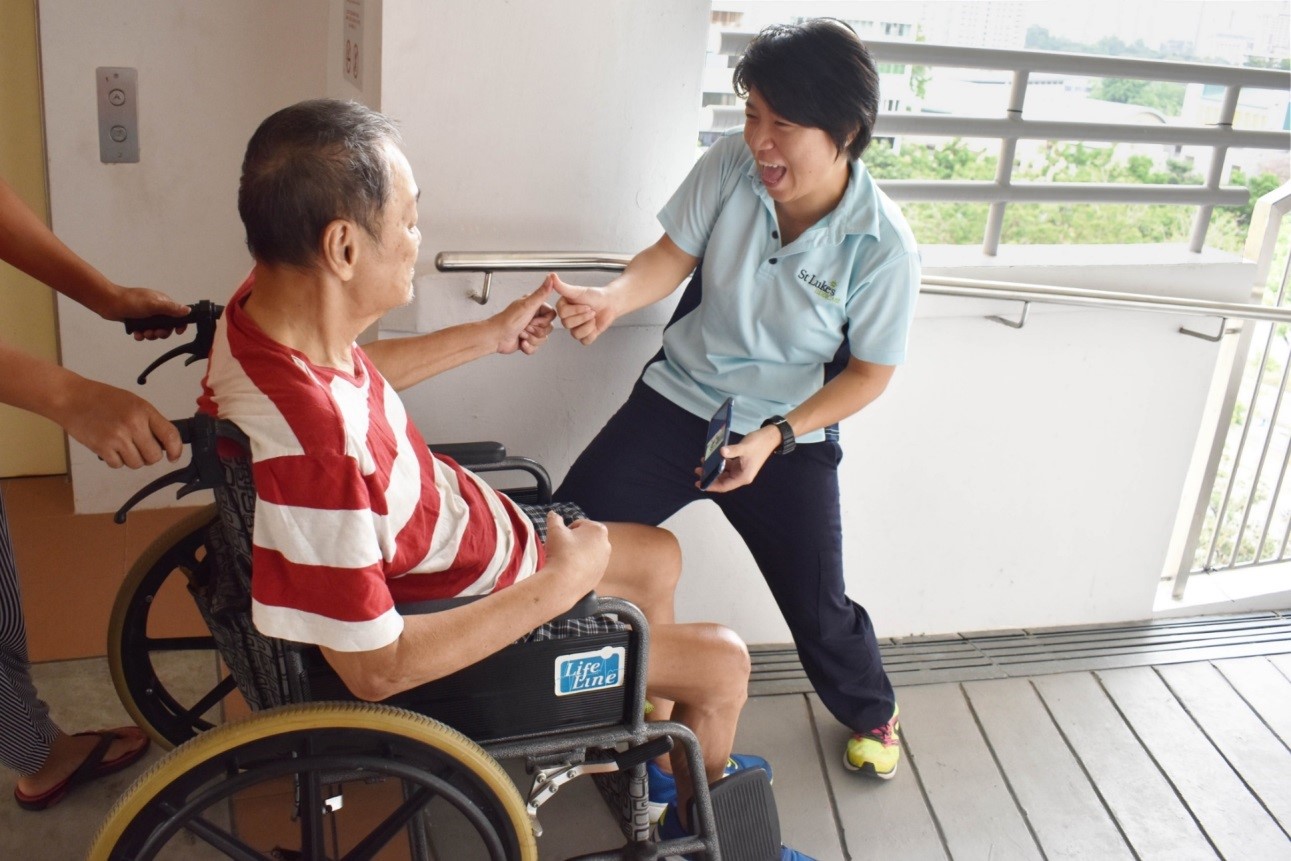Physiotherapy at Home

Oranges, Coke bottles, and bubble tea straws are just some tools of the trade for physiotherapists like Ms Chua Pei Shan, from St Luke’s ElderCare, who uses her creativity and improvisation skills to liven up home-based therapy for seniors under her care.
Mr Henry Ho, 73, has just finished his breakfast when Ms Chua Pei Shan, Senior Physiotherapist from St Luke’s ElderCare, arrives for her second home visit. It is a sunny Friday morning but the curtains of the living room are drawn and the front door is shut. In the centre of the room is the hospital bed where Henry, a wheelchair user, sleeps.
The former coffee shop owner was put out of work and into social isolation after a stroke six years ago. Today, Pei Shan is ready to progress to the next milestone in his physiotherapy, which is to help Henry take his first steps in six years.
At their first session a week earlier, Pei Shan worked with Henry on how to ease the process of transferring him from bed to wheelchair.
“While we were practising scooting across the bed, I could sense that Henry has the strength to do much more.”
What is Physiotherapy?
Physiotherapy targets impairment to restore an individual’s physical function and enable them to return to their social role. Physiotherapists serve anyone from infants to seniors. They may be sited in intensive care units, hospital wards, clinics or at home. Heart-lung issues, neurological conditions like stroke, musculoskeletal problems like neck or back pain, and even cancer rehabilitation are among the typical conditions for which people need physiotherapy.
Overcoming Challenges and Getting Creative in a Home Setting
As physiotherapy embraces exercise as rehabilitation, physiotherapists most commonly use gym equipment to target specific muscle groups. However, in the home setting, access to such equipment is greatly limited. For seniors that require maximal assistance, the work can be extremely physically strenuous for a solo therapist like Pei Shan.

On the flipside, creativity thrives in such limitations. Pei Shan improvises sports, games and functional tasks to make therapy fun. In her repertoire, oranges have become wheels of a tray for stroke survivors to practise arm protraction and retraction on their dining table; Coca Cola bottles and bubble tea straws help to train lungs; photographs become a memory game and poker cards make great hand therapy tools.
Today, the rails that line the common corridor will be the support bars for Henry. Pei Shan starts off getting Henry to practise pulling on them. In between, she also massages his fingers to get them warmed up for gripping the rails. Once warmed up, she gets him to plant his feet on the ground, and uses her right foot to block him from slipping forward.
“Uncle Henry, you pull and I push, okay? Trust me.”
Henry adjusts his hands on the bars as Pei Shan places a hand on the small of his back. Henry pulls himself forward, and Pei Shan supports his back. Trembling slightly, his knobbly knees straighten as Henry lifts off the wheelchair and sees for the first time in years, over the safety railing of the common corridor. His eyes seemed to sparkle anew in the sunlight, scanning this way and that to take in the expansive view of his neighbourhood – the nearby HDB blocks, the carpark and the construction workers milling busily about.
“See, Uncle Henry. That’s a day rehabilitation centre, when you get stronger, we can exercise there.”
Pei Shan then asks Henry what sort of music he likes. He struggles with speech because of his stroke, but through a series of questions and nods, Pei Shan understood that he likes English music. She tries her luck with an Elvis Presley playlist. The effect on Henry’s morale is palpable. Pei Shan suggests that they dance and as they sway to the beat of “Can’t Help Falling in Love”, the usually deadpan Henry breaks out in a bright toothy grin.

Benefits of the Home Setting
Home therapy typically costs more than centre-based services but Pei Shan, who had previously worked in a community hospital for seven years, reasons, “Here, I can better address the needs of each senior through these one-to-one sessions, working with the environment they are in daily. The familiarity of home means I just have to show them how to do their exercises, and it is easier for them to gain the competence and confidence to carry on without me. If they are conscientious and practise regularly, this can really accelerate their rehabilitation.”
Strong family and community bonds can also help.
“My seniors are more compliant to our exercise regime because they are motivated to return to their kopi-kakis and grandchildren make the best cheerleaders!”
Henry is silent, focused on doing his exercises right. The earlier exercises lead Henry from pulling onto the bar to standing and finally holding onto Pei Shan - taking shaky but determined steps. These few paces outside of one’s home are easily taken for granted for most of us, but today, Henry is victorious.
Pei Shan also trains caregivers so they can facilitate exercises in her absence. While Henry rests in his wheelchair (and practises shoulder rolls), Pei Shan guides his domestic helper on an exercise to train Henry’s legs safely on a gentle ramp.
Well-intentioned caregivers often want to prevent falls by keeping loved ones safely seated or lying down, but this also leads to further frailty. This is where a home physiotherapist can intervene to show the opportunities for rehabilitation at home.
Pei Shan recommends her colleagues to try home visits, “The lack of access to the full suite of allied health professionals in one place may seem limiting but home therapy allows me to see individuals holistically.”

Read the first part in this series here: Speech Therapy at Home.
The cost of this service starts from $116 per visit before means-testing subsidy. Subsidies ranging from 15% to 80% are available for means-tested Singaporeans and PRs. For more information, please visit http://bit.ly/2qLeTxe.
